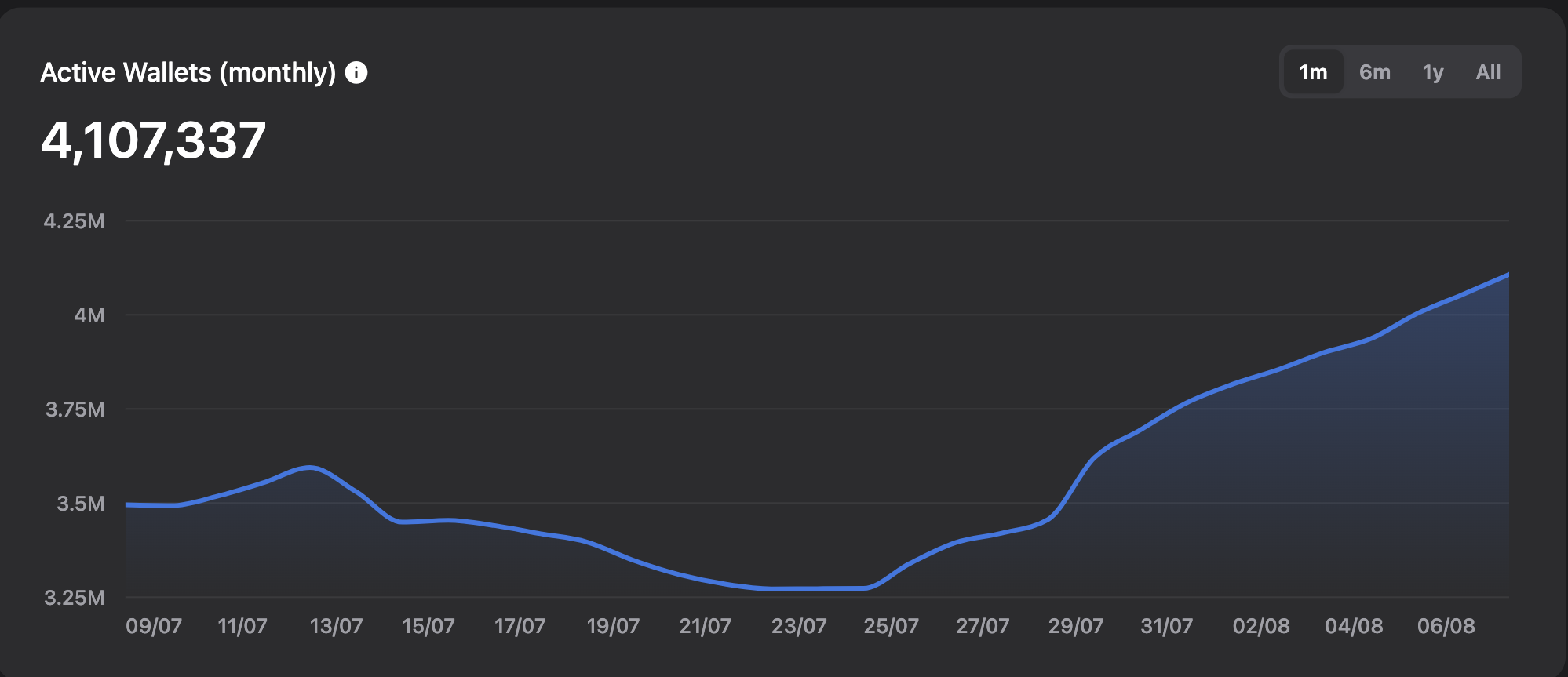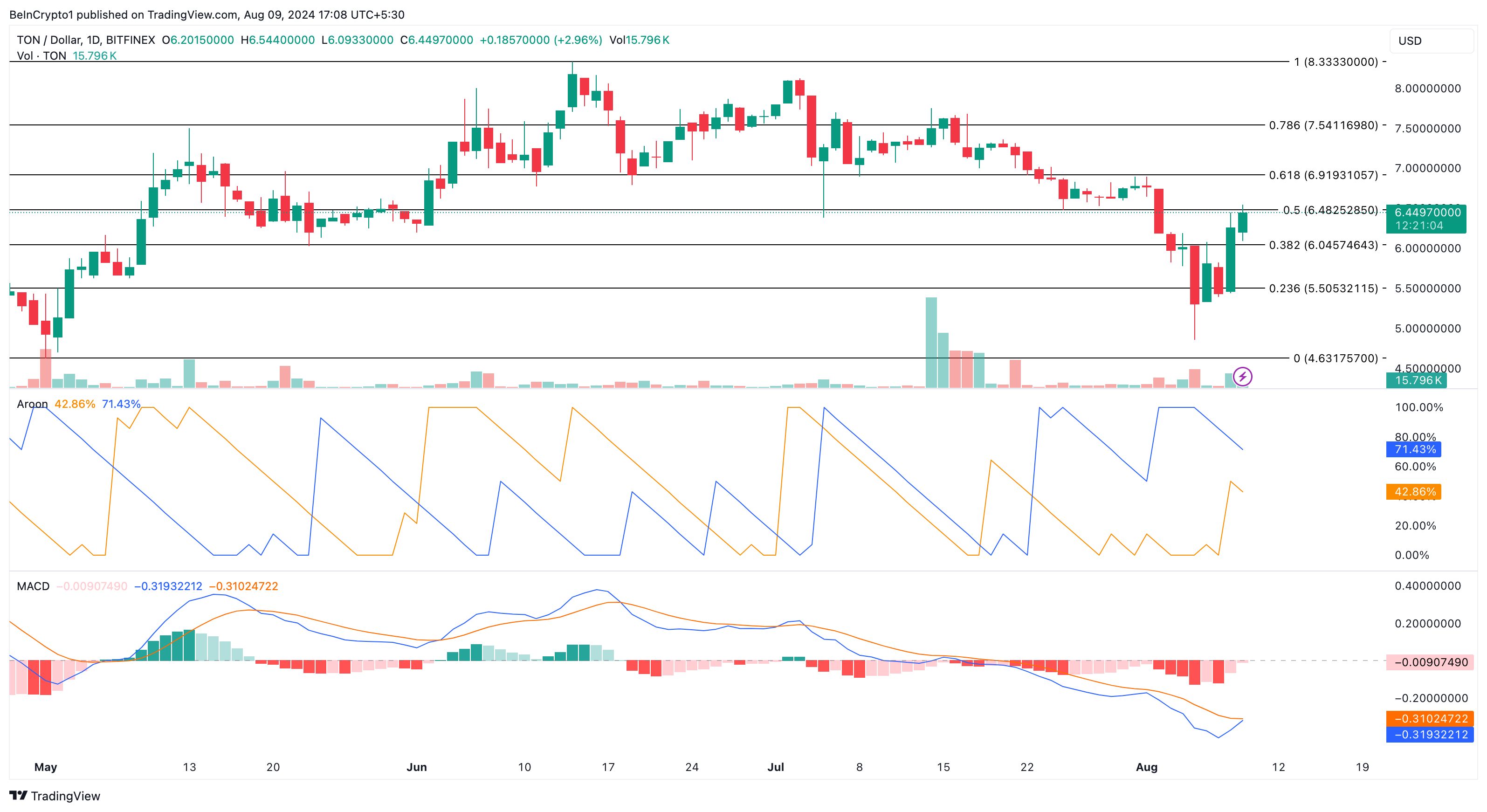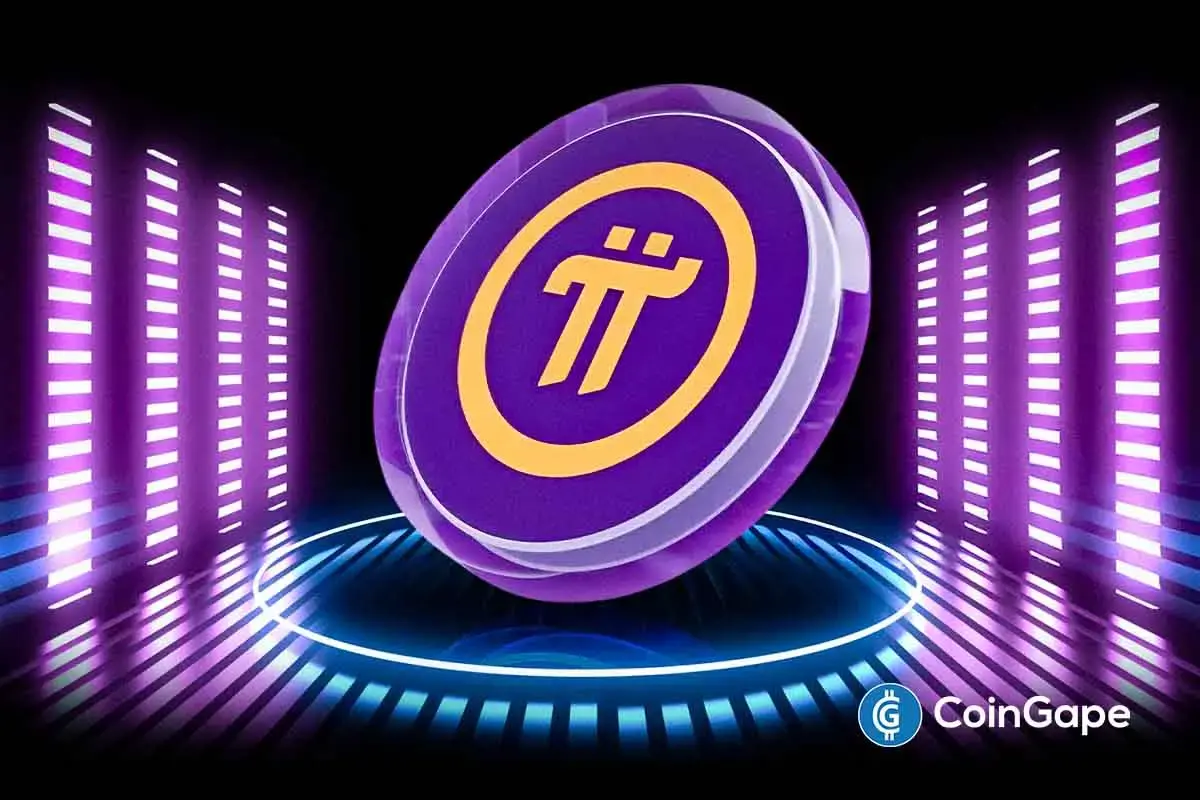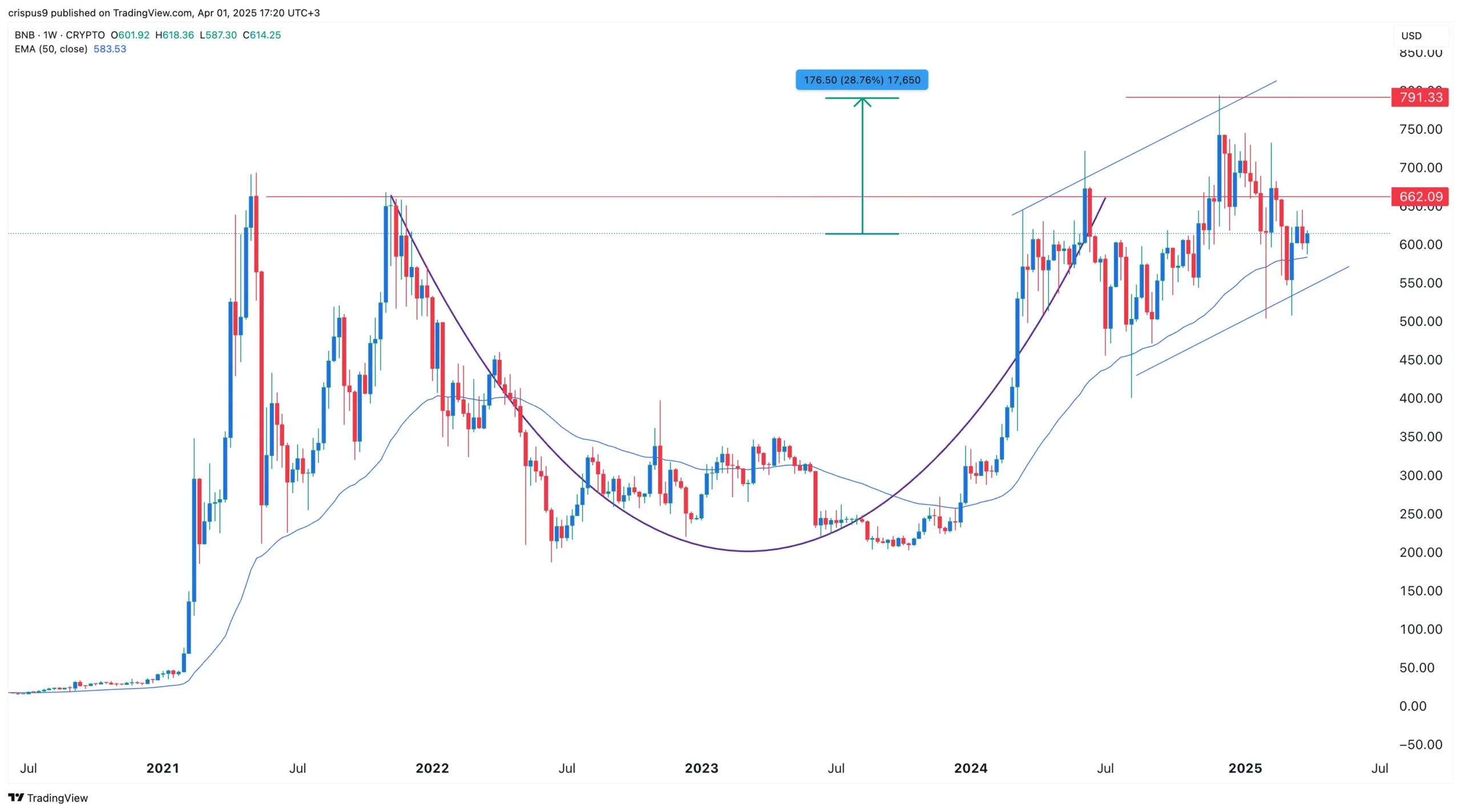Altcoin
Will Toncoin (TON) Falling Transactions Derail Its Price Recovery?

Telegram-based project Toncoin (TON) has emerged as one of the breakout blockchains of this cycle. This success is driven not only by the token’s price performance but also by the significant level of adoption it has achieved.
However, despite Toncoin’s many achievements, the blockchain faces challenges that could impact its price.
A Double-Edged Sword Appears on Toncoin
One area where the project has excelled is active wallets. According to TON Stat, the number of monthly active wallets has surpassed four million, driven by over 500,000 new accounts joining the network since the start of August.
The 30-day active wallets metric tracks the number of wallets involved in at least one successful transaction. For Toncoin, this growth is largely attributed to active participation in tap-to-earn platforms on the chain.
For instance, projects like Tapswap and Hamster Kombat continue to register a good level of user adoption. Alternatives, including Catizen and Blum, have also played major roles in helping Toncoin hit this milestone.
Read More: What Are Telegram Bot Coins?

Despite the surge in traction, TON has struggled to maintain a strong number of daily transactions. Typically, an increase in transaction value boosts the network’s share of fees and revenue.
Moreover, higher transaction volumes can support the token’s recovery, especially if a significant portion involves buying the native token. On August 8, TON’s total transaction volume reached $11 million. However, at press time, this figure had dropped nearly threefold to $3.2 million.

This decline suggests waning interest in the cryptocurrency. If this trend continues or worsens, TON’s price could be similarly impacted.
TON Price Prediction: $6 Is Key
Toncoin trades at $6.44, and it attained this point after Binance listed the cryptocurrency. According to the daily chart, TON is on the verge of wiping out the losses it had between August 1 and 5.
However, the Aroon indicator suggests that this uptick may stall soon. The Aroon indicator, which measures the strength of a trend, consists of two lines: Aroon Up (orange) and Aroon Down (blue).
At press time, the Aroon Down line has a higher value than the Aroon Up, indicating that TON’s upswing may soon be neutralized. Additionally, the Moving Average Convergence Divergence (MACD), which measures momentum, is currently negative.
The MACD’s position implies that the momentum surrounding the token is largely bearish. If this trend continues, it could lead to a price decline.
Read More: 6 Best Toncoin (TON) Wallets in 2024

If this is the case, the price of TON may drop to $6.04. However, sustained buying pressure from bulls could push the price higher, potentially reaching $6.91.
Disclaimer
In line with the Trust Project guidelines, this price analysis article is for informational purposes only and should not be considered financial or investment advice. BeInCrypto is committed to accurate, unbiased reporting, but market conditions are subject to change without notice. Always conduct your own research and consult with a professional before making any financial decisions. Please note that our Terms and Conditions, Privacy Policy, and Disclaimers have been updated.
Altcoin
Pi Network Faces Community Backlash, Is Pi Coin Price Heading to Zero?

Pi Network seems to be losing ground as Pi Coin price continues to face strong selling pressure, dropping another 4% and slipping under $0.70. Furthermore, the PI trading activity in the ecosystem is also dropping, showing that the investors’ euphoria is fading away quickly. Also, the PI token unlocks happening over the past week and so have led to a negative sentiment.
Pi Network Faces Backlash Despite PiFest Announcement
Earlier today, the Pi Core team announced that the inaugural PiFest on the Open Network saw record participation, with over 125,000 registered sellers—including more than 58,000 active sellers—and 1.8 million Pioneers utilizing Map of Pi, while highlighting Pi’s real-world utility worldwide.
However, the community doesn’t seem to be pleased by this. Commenting on the reality of the PiFest, Dr. Altcoin noted: “Since the PiFest started, Pi trading activity in the Eco-system has been at its lowest. The only trade was selling Pi for Cash”. While slamming the core team further, Dr. Altcoin stated that the Pi co-founders “seem out of touch with the realities of the everyday Pi Community”.
Other community members have slammed Pi Core Team’s communication approach, stating that it has remained unchanged since the enclosed mainnet phase. Critics like Dao world argue that the monthly updates are too predictable and insufficient for sustaining a large and engaged community.
Community members are now advocating for a more transparent communication strategy, with calls for a new leadership figure who has a deep understanding of cryptocurrency.
Pi Network Reduces Base Mining Rate by 1.18% This Month
The Pi Network’s base mining rate has dropped by 1.18% this month, now standing at 0.0029030 π per hour. This adjustment continues the network’s trend of gradual mining rate reductions. Some community members speculate that the declining interest in mining may be linked to Pi’s current low trading value on exchanges.
Despite talks of the Pi Network listing on top crypto exchanges like Binance and Coinbase, it hasn’t fructified so far. However, the BTCC exchange stated that it has added the cryptocurrency for spot trading, but it failed to add any upward momentum to the Pi coin price.
Where’s Pi Coin Price Heading Next?
Over the past seven days, the Pi coin price has tanked by 20%, with the next crucial support levels at $0.60. Furthermore, the correction under $0.70 comes with heavy selling pressure as daily trading volumes tanked 52% to $148 million.
Pi Network is currently forming a classic falling wedge pattern, testing the lower boundary near $0.687. A confirmed breakout with volume above the $0.71–$0.72 range could signal a bullish move, potentially pushing the price toward $0.75–$0.78, where key resistance levels lie.


Some market analysts still have the hope that PI cryptocurrency could reverse the trajectory to hitting highs of $3 and above.
Disclaimer: The presented content may include the personal opinion of the author and is subject to market condition. Do your market research before investing in cryptocurrencies. The author or the publication does not hold any responsibility for your personal financial loss.
Altcoin
PENDLE Price Jumps 8% Today Amid Huge Whale Accumulation

PENDLE price has led the broader market gains this Wednesday, pumping nearly 8% amid bullish developments. Recent whale metrics indicated that large-scale investors bought roughly $8 million of the token, whereas a crypto exchange behemoth also listed it previously. In an upshot, traders and investors are eyeing more gains in the asset’s price due to recent advancements that underscore rising demand for the crypto.
PENDLE Price Jumps 8% Amid Bullish Whale Transactions
As of press time, PENDLE price witnessed an 8% uptick in value and exchanged hands at $3.05. The crypto’s 24-hour low and high were registered as $2.84 and $3.07, respectively.
On a keynote, the rising price action aligns with the heightened buying pressure bought by whales in recent days. The latest data from tracker Lookonchain showed that whales bought roughly $8 million worth of coins in the past 5 days. Per the data, five newly created wallets collectively accumulated the aforementioned amount.
Here Are The PENDLE Whale Addresses Captured:
-0x21fBA58b20f62397c015b1f5a15f742ad430dFA
-0x2EB48c60F4ea75fa0a0Ff5BB017EBD9f5981b8F5
-0x11DFEDf01B3FA824BbCB138159B2e6AFE43692a3
-0x981D8856f572Fb076626265114EAD67697dA5501
-0x6478C8681ADC3E7a0C17Aa1E1F0Ff16d1A61a8f6
Why Are Whales Accumulating?
Meanwhile, the rising whale accumulations and PENDLE price upswing fall in line with another bullish development. Crypto exchange behemoth Coinbase unveiled a listing for the token at the end of March last month.
As a result, large-scale investors are hoarding massive amounts of the token, aiming to capitalize on emerging market opportunities.
Historically, listings on top crypto exchanges usually usher a bullish price action as they substantially increase an asset’s market exposure, thereby welcoming more funds from investors. CoinGape previously reported another similar chronicle, wherein cryptos BROCCOLI and TUT price rallied with their listings on Binance. Similarly, the Coinbase listing appears to be a vital catalyst for driving the whale frenzy and recent price upswing.
Can Bullish Developments Fuel Bull Run Ahead?
Usual market sentiments continue to tilt in favor of bulls, given the Coinbase listing and rising whale accumulations. Further, a renowned crypto market trader has poured additional optimism surrounding the coin’s future price action with his bullish prediction.
Analyst AMCrypto recently took to X, revealing that PENDLE price is forming an “inverse head and shoulder pattern.” This pattern formation suggests that a potential trend reversal from bearish to bullish is brewing amid bullish advancements.


In light of this dynamic, the analyst predicts that a break above $3 paves the way for a massive rally ahead. As mentioned above, the coin is currently trading above this price level. As a result, market watchers continue to weigh further bullishness on the asset’s long-term price prospects.
Disclaimer: The presented content may include the personal opinion of the author and is subject to market condition. Do your market research before investing in cryptocurrencies. The author or the publication does not hold any responsibility for your personal financial loss.
Altcoin
Will BNB Price Rally to ATH After VanEck BNB ETF Filing?

Asset manager VanEck has registered for a proposed BNB exchange-traded fund (ETF), the latest among the list of its new crypto ETF filings. As a result, the trading volume for BNB Coin has shot up by 42% to more than $2.12 billion, as analysts are now closely watching for a BNB price rally to all-time highs.
In BNB Price Ready for A Mega Rally?
BNB Coin has performed relatively well over the past month compared to Bitcoin and other altcoins. While BTC and top altcoins like ETH, SOL, XRP saw double-digit losses in March, BNB Coin is down just 1% on the monthly chart. After a strong consolidation of around $610 levels, the BNB price could be eyeing a strong breakout to new all-time highs.
BNB Burn and Pascal Hardfork Offer Support
BNB Coin features a real-time burn mechanism that permanently removes a portion of gas fees from circulation. Over the past seven days, 951.85 BNB worth $571,747.74 was burned, contributing to a total burn value of nearly $160 million, as per data from BNBBurn.
BNB’s price recently gained momentum following the implementation of the Pascal hard fork, which enhanced its compatibility with Ethereum. The network is preparing for additional hard forks this month and in June, aimed at further improving transaction speeds.
Additionally, BNB Chain is gaining a lot of popularity among meme coins, adding support for Mubarak meme coin, CZ’s Dog BROCOLLI meme coin, and others.
Looking at the technical setup, the BNB price chart shows that the altcoin is forming a cup-and-handle pattern, along with an ascending channel pattern formation, as shown in the image below.


On the other hand, BNB price is trading above the 50-day moving average, which is a positive indicator. But for the altcoin to kickstart a rally to its all-time high of $790, it must first complete the handle formation at $662, and give a breakout above that level.
As of press time, BNB Coin is trading at $603 levels with its daily trading volume up by 42%, surging past $2.12 billion. Furthermore, the Coinglass data shows that the BNB options trading volume is also up by 46%.
VanEck Files for Spot BNB ETF
$115 billion asset manager VanEck filed for the spot BNB ETF in Delaware on Tuesday, April 1, which could serve as a major catalyst for the BNB Coin rally ahead. The proposed BNB ETF would follow the price of BNB, the fifth-largest cryptocurrency by market capitalization.
Apart from BNB, VanEck has already submitted crypto ETF applications for Bitcoin, Ether, Solana, and Avalanche. VanEck filed for SEC approval last month to launch the first AVAX ETF, building on its success with spot Bitcoin and Ethereum ETFs.
Disclaimer: The presented content may include the personal opinion of the author and is subject to market condition. Do your market research before investing in cryptocurrencies. The author or the publication does not hold any responsibility for your personal financial loss.
-

 Market24 hours ago
Market24 hours agoBitcoin Price Battles Key Hurdles—Is a Breakout Still Possible?
-

 Bitcoin21 hours ago
Bitcoin21 hours ago$500 Trillion Bitcoin? Saylor’s Bold Prediction Shakes the Market!
-

 Market21 hours ago
Market21 hours agoCoinbase Stock Plunges 30% in Worst Quarter Since FTX Collapse
-

 Altcoin20 hours ago
Altcoin20 hours agoWill XRP, SOL, ADA Make the List?
-

 Bitcoin22 hours ago
Bitcoin22 hours agoBig Bitcoin Buy Coming? Saylor Drops a Hint as Strategy Shifts
-

 Market15 hours ago
Market15 hours agoEthereum Struggles to Break Out as Bear Trend Fades
-

 Market20 hours ago
Market20 hours agoEthereum Reclaims Top DeFi Spot As Solana DEX Volume Drops
-

 Market14 hours ago
Market14 hours agoHow Did UPCX Lose $70 Million in a UPC Hack?

















✓ Share: